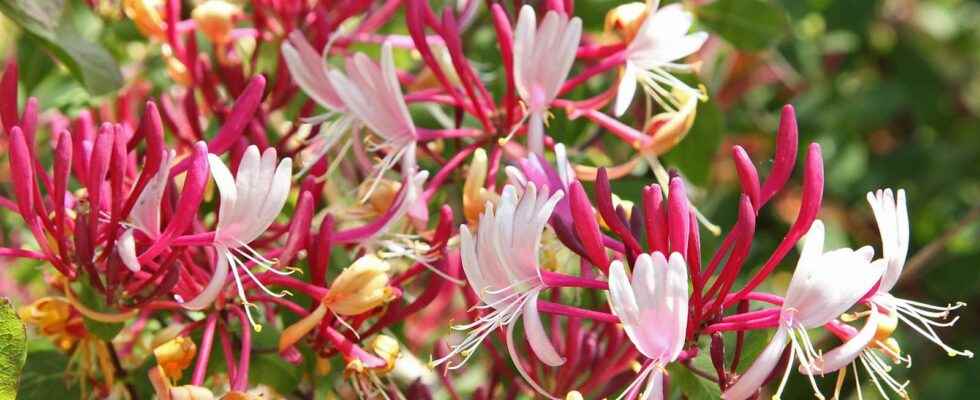A climbing or shrubby plant, honeysuckle is covered with shiny green foliage, small, very colorful and very fragrant flowers that perfume gardens and the balconies from March to December, depending on the variety.
Appellations
Honeysuckle (Lonicera) is a vine which produces twining lianas that can reach several meters in length or shrubby which forms small shrubs, depending on the species cultivated. It is a member of the Caprifoliaceae family (Caprifoliaceae).
Botanical description of honeysuckle
Honeysuckle develops multiple tubular flowers, quite divided at the colors varied, yellow, orange, pink, white or red, depending on the varieties grown. Discover some species and varieties from a wide choice of honeysuckle:
- Lonicera fragrantissima (honeysuckle ofwinter), shrub which blooms in winter and is covered with numerous small, very fragrant white flowers;
- Lonicera tatarica (Tartarian honeysuckle), a shrub that carries flowers dews from April to June;
- Lonicera japonica ‘Aureoreticulata’a climbing plant which has the originality of developing semi-evergreen foliage, green ribbed with yellow, very decorative;
- Lonicera japonica ‘Mint Crisp’creeper with variegated leaves and yellow and white flowers;
- Lonicera nitida (shrubby honeysuckle), evergreen shrub, very small in size similar to boxwood;
- Lonicera heckrotii ‘Gold Flame’a vine that bears very fragrant flowers from June to September;
- Lonicera pileata (honeysuckle to cup), very small evergreen shrub;
- Lonicera japonica ‘Hall’s Prolific’a climbing plant that bears a multitude of yellow flowers from July to September;
- Lonicera periclymenum (honeysuckle of wood), a climbing plant with abundant and very fragrant flowering, from July to September;
- Lonicera caerulea kamtschatica (blue honeysuckle), also called Mayberry or Blue Haskap. Small shrub that is covered with edible blue berries in May and June.
Origins of honeysuckle
He is known to have Asian and Northern European origins.
Honeysuckle Cultural Requirements
When planted in the spring or in fall, honeysuckles require little maintenance apart from an annual pruning in the fall to keep their silhouette and channel them. Enjoy this cut to tie the vines. From semi-shade to Sun, adopt the correct exposure depending on the variety being grown. Hardy down to -15°C, they stay in place without winter protection. You can bringfertilizeronce in the spring, to amend the soil and promote an exuberant flowering.
Use of honeysuckle
Climbing honeysuckles are used to cover a trellisa fence, a railing or a arbor. Their bewitching fragrance seduces gardeners in places of passage. As for the shrub honeysuckles, they are cultivated in isolated subject, in hedge or on the edge. Deciduous, evergreen or semi-evergreen, there are honeysuckles for every use. Ask a garden center salesperson for advice. Honeysuckle likes to be grown in pot or in a container on a balcony or Terrace. It will suffice to ensure the watering the first years, to enrich the substrate and prune the vines every year.
You will also be interested
Interested in what you just read?
